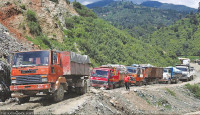Opinion
Spend it wisely
Remittance should be used to create jobs, generate income and boost entrepreneurship
Dutta Shree Duwadi (khanal)
Remittance has contributed a lot to Nepal’s economic development. If this money sent home by Nepali migrant workers abroad is properly channelled to the productive sector, it can increase employment opportunities and help build new infrastructure and services. Remittance also pays for the daily expenses of many poor households, and it has been a key factor in reducing poverty. Moreover, the inflow of cash has become one of the major sources of foreign currency for the country. It makes up a substantial component of the current account surplus in the balance of payments.
However, the downside of remittance is the possibility of young people permanently leaving their homeland as they spend long periods away from their families. Thus, in order to prevent the loss of an economically active labour force to the domestic economy, they should be encouraged to come back with skills, knowledge and experience and utilize their savings to develop the productive areas as per the national development plans. According to government records, around 1,500 Nepalis leave the country daily in search of jobs abroad.
Despite the billions of dollars flowing into the country annually, directing this cash flow towards productive investment has posed a challenge. According to a report, only four percent of the remittance is used in capital formation. More remittance money is spent on the import of non-durable consumer goods than on capital formation, thus widening the trade deficit year after year. Nepal’s imports are eight times higher than its exports. Thus there is a need to develop appropriate policies and strategies so that the remittance is used for positive growth to create jobs, generate income and promote entrepreneurship.
Reason for urbanisation
After the terrible earthquake on April 25, the flow of remittance increased by a notable amount as migrant workers have been sending back money to rebuild their damaged houses. Although the use of banking channels has increased in recent days, the hundi system is still widely used. A number of banks and remittance companies waived their service charges for over a month after the disaster. This has helped increase the remittance inflow through formal channels. Therefore, the government should extend support and exploit new markets so that Nepali workers can get an advantageous deal. Remittance will continue to play a significant role in improving the living standard of millions of Nepalis for many years to come, but the government and policymakers must understand that it might not be a good idea for the country to rely on this income in the long term.
As per the World Bank’s latest report on Migration and Development Brief, remittance accounts for 25 percent of Nepal’s Gross Domestic Product (GDP), which is the highest among South Asian countries. In 2012, Nepal received Rs 430 billion in remittance to take the fourth place behind India, Bangladesh and Pakistan. The last decade has not only seen a significant increase in remittance flows to Nepal, there has also been a tremendous growth in urban areas. As per a 2013 report, Nepal is the fastest urbanising country in South Asia, with many cities, including the Kathmandu Valley, recording an annual growth rate of four percent. Remittance is one of the drivers behind this runaway expansion. This growth has happened in an unplanned and haphazard manner, resulting in increased levels of earthquake vulnerability.
Remittance policy
In South Asian countries like India and Pakistan, remittance has contributed significantly to economic development. Given the huge scale of joblessness in Nepal, where around half a million youths enter the job market every year, there is almost no alternative but to go abroad to find work. The government of Nepal must develop a strategy and separate policy to promote the use of official remittance for productive and safe purposes. There must be a financial literacy programmes, advisory services for migrant workers, opportunities to invest in government bonds, promotion of micro finance institutions and the identification of remittance as an industry rather than service.
Since remittance flow is closely linked to foreign employment, it seems to have been tied with the foreign employment policy. There is a need for developing a separate remittance policy integrated with foreign employment policy to attract remittance in the country. This separate policy will help to create a faster, cheaper, convenient and efficient flow of remittance through formal channels. Moreover, this separate policy could also encourage the productive use of remittance and provide easy access to various transfer systems. The country needs a coherent remittance policy to maximise the benefits of remittance in nation building. The government should formulate a separate remittance policy to resolve the problem of coordination and accountability besides encouraging the inflow of remittance through formal channels.
Duwadi (Khanal) is a me manager at the South Asian Institute for Policy Analysis and Leadership




 23.12°C Kathmandu
23.12°C Kathmandu










